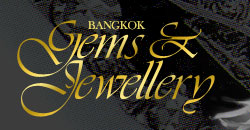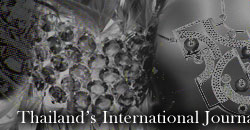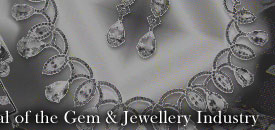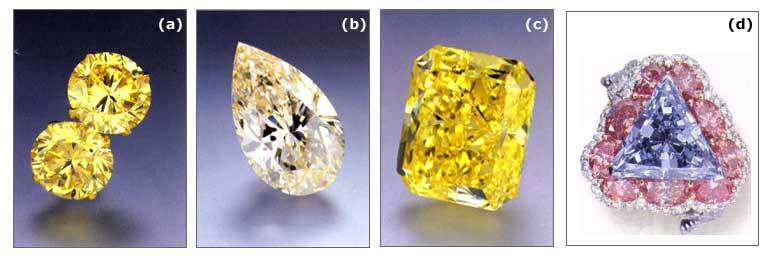 |
 |
 |
| Fancy Vivid Coloured Diamonds and Jadeite Jewellery Set the Tone for Christie's Hong Kong Spring Sale | ||||
. Fancy vivid coloured diamonds and jadeite jewellery will set the tone at Christie's Hong Kong "Spring "Sale, which will be held on June 1. Christie's Hong Kong Magnificent Jewellery and Jadeite Jewellery Sale comes on the heels of a year of tremendous growth in a vigorous jewellery market in 2004. This auction marks the first time that Christie's will be staging a sale at the internationally renowned Hong Kong Convention and Exhibition Centre. It is designed to attract enormous interest from buyers around the world. . Colours in diamonds are the result of inclusions or changes in the molecular structure of the stone. The inclusion of boron thus results in a blue diamond and the presence of nitrogen makes the stone yellow. Pinks and reds on the other hand, seem to be the result of molecular distortion. Whatever the cause, the fact is that coloured diamonds are extremely rare and fancy vivid coloured ones even more so. . In order to standardise the classification of coloured diamonds, the Gemological Institute of America (GIA) introduced a specific scale of grading coloured diamonds and fancy vivid colour comes at the top end of the scale. |
||||
 |
||||
| a) An Important Pair of Fancy Vivid Yellow Diamond
Ear Studs of 4.57 and 4.74 cts. b) An Unmounted Radiant-Cut Fancy Vivid Yellow Diamond, weighing 30.09 cts. c) A Rare Unmounted Pear-Shaped Faint Brown Diamond, weighing 120.20 cts. It is the largest diamond to be offered at auction in Asia. d) A Superb Vivid Blue Diamond and Pink Diamond Ring. |
||||
At the Hong Kong Spring Sale, Christie's offers several major fancy vivid coloured diamonds including a super unmounted fancy vivid coloured yellow diamond of 30.09 carats in radiant cut (est: HK$5,200,000-6,500,0007 US$650,000-800,000). Equally splendid is a pair of 4.57 and 4.74 carat brilliant cut earrings with unparalleled saturation of intensity and colour (est: HK$4,000,000-5,000,000/US$515,000-640,000). The highlight of the group though, is a magnificent necklace of Asscher cut and rectangular cut fancy vivid yellow colour diamonds totalling 42.41 carats. Both the Asscher and the rectangular cuts are unusual choices for coloured diamonds. The Asscher cut requires very precise specifications and entails a great deal of weight loss during cutting, while the rectangle cut is very demanding in its display of the stone's colour and is thus generally considered unsuitable for coloured diamonds. This necklace is composed of one of the most selected group of such diamonds ever offered at auction and is comprised of a total of nine Asscher and rectangle cut stones, all in matching vivid colour and with an even colour distribution. It is estimated at HK$ 18,000,000-25,000,000/US$2,300,000-3,200,000. |
||||
 |
||||
Other fancy vivid coloured diamonds on offer include an extraordinary 3.10 carat oval fancy vivid purplish pink diamond ring, which displays a very bright candy colour (estimate : HK$12,000,000-16,000,000/US$1,500,000-2,000,000) as well as a stunning 3.32 carat modified triangular cut fancy vivid blue diamond ring, internally flawless (est: HK$6,700,000-8,000,0007 US$850,000-1,000,000). The other highlight of the sale is without doubt a rare and unmounted 120.20 carat pear-shaped faint brown diamond — the largest diamond ever to be offered at auction in Asia (est: HK$4,800,000-6,400,0007 US$600,000-800,000). In lan Balfour's acclaimed book "Famous Diamonds" he lists only 46 diamonds in excess of 120 carats, many of which are in museums or private collections. This magnificent faint brown diamond, the 8th largest pear-shaped diamond known to exist, is exceptional not only due to the size - the original crystal must have been approximately 200 carats - it is amazing that such a large stone is practically free of inclusions. The beauty of this pear-shaped diamond is unique and the finely crafted facets are designed to enhance the remarkable transparency and fascinating colour of this amazing diamond, which is undoubtedly amongst the finest and largest diamonds to be offered at auction in recent years. |
||||
 |
||||
Continuing to uphold Hong Kong's reputation as the most important auction centre for jadeitc jewellery of superb quality in Asia, Christie''s will be offering jadeite jewellery of the highest quality in the sale. One of the highlights is an exceptional jadeite and diamond necklace (estimate: HK$3,800,000-4,800,000/US$480,000-600,000) with a cabochon pendant of impressive size, translucency and colour. Carved from the finest quality jadeite from Burma, the superb cabochon possesses the perfect combination of very fine texture, a vivid emerald green colour and even colour distribution. The thickness and ideal proportions both contribute to the beauty of the stone, and a cabochon of such perfection is a rarity in today's jadeite market. Bead necklaces are considered to be amongst the most valuable jadeite jewels. To obtain a jadeite bead necklace, the rough has to yield a fair size patch of the same colour and evenness. In addition, when cutting jadeite beads, there is a much higher risk of cracking than for any other types of shapes and the process is entrusted to the hands of only the best craftsmen. |
||||
|
||||
Deceptively
simple in its design, a jadeite hoop of fine-textured glassy material
and vivid emerald green colour is another ighlight. With jadeite hoops
and angles, one has to be willing to acrifice a significant amount of
laterial and therefore only the best quality rough material of sufficient
thickness, strong evenness and saturation of colour could yield such
a beautiful carving (estimate: HK$2,000,000-3,000,000/US$250,000-380,000). Large, well proportioned pearls in an important pair of natural pearl and pink diamond ear pendants, each set with a drop- shaped and button-shaped natural pearl of beautiful lustre and colour (estimate: HK$2,800,000 - 4,000,0007US$350,000-500,000) are also part of the sale. An unusual necklace by Etcetera feature stylish combination of grey i brown natural pearls intricately-cut spinels inlaid il ashoka-cut diamonds (estimate: HK$2,400,000-4,000,000/US$300,000-500,000) is among the highlights of natural pearl jewellery in the sale. The design is innovative, simple and elegar The Magnificent Jewellery a Jadeite Jewellery sale also in many pieces of signed jewellij from private collections jewellery without a reserve price. |
||||
. Imagine if you lived 2000 years ago and happened to come by a gemstone that is like no other. A gem that glows with a mysterious inner light, which seems to float through the translucent colourless body of the stone like a moonbeam falling to earth at night. What would you call such a gem? If you guessed moonstone, then you are right on the money with that one. The ancient Romans in fact did believe that moonstone was made out of frozen and solidified rays of moonlight and called it Lunaris. They even believed that moonstones changed their look during the lunar phases and that the picture of Diana, Goddess of the Moon, could be seen in the depths of every specimen of this gem. |
||||
 |
||||
These are modern times however, and all natural phenomenon that once awed the ancients now have perfectly plausible explanations based on the principles of science. Thus, the beautiful floating moonlight within the body of the moonstone also has its scientific name and explanation. This floating glow is called "adularescence" by gemologists and the "schiller effect" by geologists. By either name, it is essentially the calling card of this gem and the soJe factor that makes it so special. Moonstone is in fact a memte of the feldspar group of minerals, which is the most abundantly i in the world. Feldspar is the given to a group of crystal aluminosilicate minerals moonstone is the result of at la two of these minerals combinisj within a single stone. It is i intergrowth of two different types of feldspar (typically orthoclase and albite), with two different refractive indexes that causes the adularescence of moonstone. These mtergrowths result from compatible chemistries at high temperatures becoming incompatible at lower temperatures and thus separating and layering when the stone cools down during its genesis. |
||||
 |
||||
|
Thus,
a ray of light entering the stone is repeatedly refracted back and forth
between the layers before 'ifing refracted out of the crystal. This
final refracted ray that leaves the stone has a different character
than the one that entered the stone and this is what produces that floating
moonlight glow in the body of the gem. Thicker individual layers produce
a silvery sheen, while thinner plates create the bluish iridescence
that is the hallmark of the finest quality of moonstone. Revealing the adularescence of this gem really depends on how it is fashioned or cut. Classically, moonstone is almost always cut into cabochons as this maximises the angles from which the schiller effect is visible. For this very reason, round beads are also commonly cut out of this gem. Cameos and carvings, especially the man in the moon faces are also very popular. However, in the past decade or so, cutters have also experimented with faceting moonstone, a tricky job at best. To facet moonstone, a cutter has to orient the adularescence to parallel the gem's table facet. |
||||
 Moonstone comes in a variety of qualities, sizes and colours. The best ones contain few or no visible inclusions, exhibit a high degree of discernible bluish adularescence, range from 3-12 carats in weight and have a colourless body colour. While the best adularescence is bluish, white with no hint of blue is far more common. The body colour of the gem may also be green, yellow, pink, grey or brown. The stone may be semi transparent or opaque, though the best specimens are semi transparent. Adularescence too varies from stone to stone. In the best quality pieces the adularescence is distinct and strong, while in the poorer specimens, it is quite indistinct. |
||||
 |
||||
Another common phenomenon in moonstone is a distinct cat's eye effect rather than a soft billowing adularescence. While cat's eye moonstone is truly beautiful in its own right, it is overshadowed by the playful now you see it now you don't shimmer of the adularescent stone. Apart from the traditional or "true" moonstone that is made up of orthoclase and albite as mentioned earlier, there is another type too.This is made up of labradorite feldspar and is far less valuable. This variety is referred to as rainbow moonstone in the trade. Unlike true moonstone, labradorite does not show any adularescence but rather it gets its sheen from a phenomenon called labradorescence, which shows distinctive directionally oriented surface display of one or more metallic looking spectral colours. It is the translucent white variety of labradorite that is sold as rainbow moonstone. |
||||
 |
||||
The structural cause of this is the repeated thin layer twinning of its crystals, which creates both diffraction and interference as light passes through and reflects from the parallel surfaces. The resulting colour shifting through the surface of the stone looks a lot like the spectrum of shades dispersed by oil or petrol on water. One of the peculiarities of this iridescence is its distinct directionality. Therefore, any gem fashioned from this material must be carefully oriented to show this display of light and colour toil best advantage and even then, it nil be visible only at certain and The thickness and uniformity of i1 individual layers that make up t stone are the factors that detenu! which colours will be seen. Moonstone tends to contain it number of typical inclusions I appear to be stress cracks. These take the appearance of centipede like insects, Chinese characters, negative cavities looking like rectangular crystals, and needle like shapes. The presence of the needles in large quantities is what gives rise to the cat's eye phenomenon. |
||||
 |
||||
Moonstone enhancements are very rare. In the older stones set in jewellery, black coatings are sometimes observed on the pavilion end. This coating was applied to enhance the stone's adularescence and it can be scraped off. Generally speaking, moonstone is not a very hardy gem and needs to be handled gently. It has a hardness of 6 - 6.5 on the Moh's scale. Its refractive index is 1.518-1.526 and its specific gravity is 2.58. While it has a distinct cleavage, it also has very poor toughness. Although moonstones are not affected by light, they are somewhat fragile. A hard knock may cleave or part a moonstone. It is also affected by hydrofluoric acid and has a very low tolerance for heat. Therefore lukewarm soapy water is the best solution for cleaning moonstones. |
||||
 |
||||
The finest quality moonstones are found in Sri Lanka, and are often referred to as the "national gemstone" of Sri Lanka. It is collected by hand by the miners who dig deep narrow holes in the earth, as mechanised mining is not allowed in the island nation. Early moonstones were generally mined from pegmatites. Pegmatites are the result of magmatic flows rich with hot waters and dissolved minerals. Due to the higli water content, the magma cools slowly, allowing for the formation of large crystals. Apart from Sri Lanka, moonstone is also found in Burma (Myanmar), Brazil, India, Madagascar and the USA. In fact, feldspar whose mineral family moonstone belongs to, is the most common mineral group in the world, It derives its name from the German term "feldt spat" meaning easily cleaved material that was thrown up when the fields were ploughed. The majority of feldspars are very dull stones, used primarily for manufacturing glass, ceramics and plumbing fixtures, hardly the stuff of romance and legends. In fact, even moonstone, which has such a romantic legend of its genesis, is very dull and boring to look at in its rough state. It is only when it is polished that it reveals its magical glimer that has entranced people over the centuries. |
||||
 |
||||
Its mystical appearance has ensured that peoples and cultures attributed a lot of mystic and iritual powers to it as well. In fact, 'ironstone is considered to be a Wed stone in India. The ancient Greek, Roman and Egyptian religions associated it with the [other Goddesses Diana, Selene nd Isis. Eastern religions believe lat moonstone has the energy ibration of "Yin", the female half fthe Yin-Yang balancing powers. herefore, most ancient religions .sociated it with fertility and hildbearing. Modern day strologers consider it to have the ower to help men awaken their eceptivity and intuition and help lem achieve emotional balance by etting in touch with their feminine side. It was also supposed to bring ood fortune and aid lovers in their romance. It has also been associated with the sea and planting cycles, no doubt via its association with fertility. Amulets of moonstone were often hung from the trees in orchards to help produce abundant crops of fruit. |
||||
 |
||||
Moonstone's mystical powers are also said to counteract ill luck, especially the negative influences of the number 13. Among its many forces are reputed to be the strength to protect against the wandering of the mind, insanity and epilepsy. Indeed, before the advent of modern medicine, many such beliefs did persist and reports of their efficacy are more a matter of faith rather than any scientific proof. There are even legends that a moonstone held in the mouth when mulling over matters helps to arrive at the right decision, a case of matter over mind perhaps. More credence can be given to the practice of using moonstones to hypnotise people and it is said that the gem helps concentration during meditation and aids in inducing deep trance states especially in the worship of the Moon Goddesses Diana, Selene and Hecate in their forms as maiden, mother and crone respectively, as per the ancient Roman and Greek pantheistic religions. |
||||
 |
||||
Funnily enough, moonstone is associated
with the moon in modern day USA as well. On July 20, 1969 American astronauts
Neil Armstrong and Buzz Aldrin landed on the moon, making it the first
time that man walked on the lunar surface. Since the Apollo 11 mission
and indeed all space flights since then, have taken off from the Kennedy
Space Centre in Florida, the State Eegislature of that state decided
to commemorate the event by naming moonstone as the official State Gem.
On March 20, 1970, Florida's lawmakers actually passed the bill, arlontinp
moonstone as the Official State Gem. What makes it ironical is that
moonstone is not found in Florida or on the moon. In light of this,
the great vote counting fiasco of the American Presidential Elections
in 2000 should not come as a great surprise. |
||||
 |
||||
Regardless of its high status with the ancients, moonstone's during the twentieth century. The end of the nineteenth and the beginning of the twentieth century probably saw the apex of its popularity when it was widely used in the sensual and mysterious jewellery of the Art Nouveau period. In the 1920's, the advent of the Art Deco movement put an end to all that. There simply was no place for moonstone in the geometric, staccato shapes that revelled in strong primary colours and vivid contrasts. Then with the end of World War II, gold jewellery came into vogue and white metal was relegated to the fuddy duddy old ladies who lunch types. |
||||
 |
||||
The new post-war mood was optimistic, and tended to exces the deprivation of the war years. In iewellery, flowers bloomed, birds stretched their wings and cornucopias overflowed voluptuously. In these graceful jewels, moonstone found a place in the sun again, often in a mix with diamonds, precious and other semi precious gems. This phase was not to last either and since then, like the moon, this gem has seen its appeal wax and wane periodically. At the moment, with current emphasis on semi precii stones and large pieces, w designers trying out all sorts materials rather than concentral on one particular stone, moonst is seeing demand wax. The w will come as well but hold or your moonstone jewellery, its apj will return as faithfully and regul; as the cycles of the moon. |
||||
C
o p y r i g h t © 2 0 0 0 - 2 0 1 6 D4U
WEB TM A l l R
i g h t s R e s e r v e d |